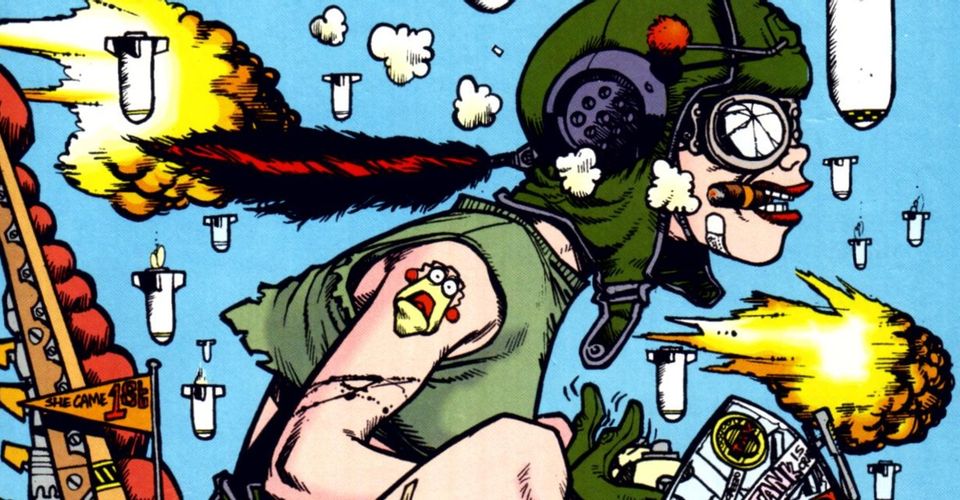Hewlett and Martin’s Tank Girl: The Original Anti-Comic

In the late ‘80s, a little known team created an essentially nonsensical comic strip featuring a vulgar and obscene “super-heroine” for a now-defunct illustrated stories magazine. It wouldn’t seem like a recipe for success, but like it or not, Tank Girl by Jamie Hewlett and Alan Martin managed to capture the hearts and minds of Britain’s rebellious youth of the period despite, or perhaps because of their wholesale rejection of the typical tropes as portrayed in the comics market. Their alcoholic, remarkably violent, uncomfortably sexual and mostly bald heroine, the titular Tank Girl, managed to capture the spirit of the day; a defiant belch in the face of Thatcherian conservatism that featured an Australian dissident with a giant tank who fought mutated kangaroos as well as seemingly everyone else who crossed her path. A statement against standard comic book fare at the time, Tank Girl represented every repressed impulse found within the cultural zeitgeist brought to life.
One might begin an overview of the amoral antiheroine by asking ‘who is Tank Girl?’ The answer would be that she’s a free-spirited girl from down under who ran afoul of the Australian military when she failed to deliver a colostomy bag to their President (who suspiciously resembles Ronald Reagan), leading to her life on the run from authorities. This would however fail to properly convey the nuance of the strip as pioneered by Martin and Hewlett, as the rules of this universe are far more in line with the cartoon hijinks of Tom & Jerry with the added violence of a Mad Max-esque bloodbath thrown in more for slapstick humor than anything else. This absurdist streak begun in the very first issue only careened more and more out of control as the strip went on, gracing the pages of Deadline Magazine from its inception in 1988 to their final issue in 1995, and featured Tank Girl performing elaborate and deadly heists for beer, engaging in mystical sorceries and being interred at a brutal insane asylum for her penchant for violence, theft and murder.

Alongside her mutated kangaroo boyfriend Booga and her equally amoral pals Sub Girl and Jet Girl, the ballistics-bearing blonde became a beacon for counter-cultural forces at the time in part due to the creative team’s active disdain for the portrayal of women in comics at the time. Rather than being a statuesque paragon of moral virtue and righteousness, Tank Girl relished her opportunities to indulge in slaughter, swore like a sailor and often paraded around nude while imbibing alcohol and drugs. The dystopian future she rebelled against was choc-full of grotesque caricatures of fans the creative team openly mocked, and the plots of later issues seemed to become less and less cohesive, involving massive dream sequences, time travel and numerous cameos and eventually co-starring roles for Hewlett and Martin themselves.
What ultimately made Tank Girl a lasting icon within comics culture was not only her anarchic irreverence but the vaunted tone of two creators who did not take themselves too seriously either. Tank Girl was among the first female protagonists in comics who not only starred on her own without any hint of an equal male counterpart, but also a character who was relatable to young people in need of a story where the specter of moral indemnification and the need to keep sanctimonious appearances was thrown to the wayside. Despite her insanity, thirst for carnage, and general habit of causing people around her to defecate in fear, what Tank Girl represented was a path away from the traditional, stale and often hypocritical values found in the time towards an absurdist vein that instead embraced silliness, ambiguity, and self-expression in such a way that celebrated individualism.

Perhaps the most enduring aspect of the legendary run of Tank Girl would be the detailed art of a young Jamie Hewlett, now more famous for his work with musician Damon Albarn in the virtual band Gorillaz. Though often shocking, cluttered and grotesquely proportioned, Hewlett’s visual sense of composition and flourishing details often imbue his worked with a fever dream-esque sense of wonder, tempered of course by the sense of unease and terror that often comes with his brand of surrealism. Stylish, scary and smart, Hewlett’s ability to bounce off of Martin’s audacious antics while adding gross-out wonder and sexy action (usually in the same panel) display the best of what indie comics can do when unfettered by censorship and publishing codes. Non-stop mockery of the oversaturated, violence-obsessed machismo of the times, with a little heart to show they cared too, sometimes.
Sadly, this story ends in 1995, when after licensing the rights for a Tank Girl movie, the pair was met with the true Hollywood ending: a box office failure of an adaptation that hardly resembled the source material. Gone was the sex, the outrageous punkiness, the devil-may-care attitude. And so, while the pair would eventually collaborate again on the 2015 release of 21st Century Tank Girl, therein ended the original creative run of Tank Girl.

However, news came in 2019 that Margot Robbie’s production company LuckyChap Entertainment has purchased the rights from MGM to make a film based on the old black-and-white strip. Though production has likely been delayed thanks to COVID-19, it’s not out of the question that Hewlett and Martin’s renegade, debauchery-laden superheroine might see the light of the silver screen in a form more as she was intended. Only time will tell, but one thing seems to be for certain, Tank Girl was written to be a survivor, and sometimes that translates to reality.
About The Author


















